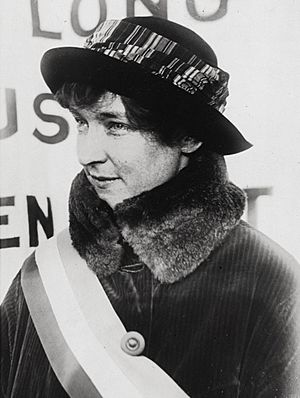Hazel Hunkins Hallinan facts for kids
Quick facts for kids
Hazel Hunkins Hallinan
|
|
|---|---|

Hunkins picketing c. 1917
|
|
| Born |
Hazel Isabell Hunkins
June 6, 1890 |
| Died | May 17, 1982 (aged 91) London, England
|
| Resting place | Mountview Cemetery, Billings, Montana, U.S. |
| Nationality | American |
| Alma mater | Vassar College |
| Occupation | Journalist, suffragist |
| Spouse(s) | Charles Thomas Hallinan |
| Children | 4 |
Hazel Hunkins Hallinan (born June 6, 1890 – died May 17, 1982) was an American champion for women's rights. She was a journalist and a suffragist, meaning she fought for women to have the right to vote.
Contents
Early Life and Education
Hazel Hunkins Hallinan was born on June 6, 1890, in Aspen, Colorado. She grew up in Billings, Montana. Her father, Lewis Hunkins, was a jeweler and watchmaker. Her mother, Ann Whittingham, was from England.
Hazel studied chemistry at Vassar College and earned her bachelor's degree. After college, she taught chemistry at the University of Missouri for three years. She also started working on her master's degree in chemistry.
However, she faced unfair treatment because she was a woman. She was not promoted, even though she was more qualified than her male co-workers. Later, she applied for a chemistry teaching job at Billings high school. She was told that only men would be considered for the position. She ended up taking a job teaching botany and geography instead.
Hazel became interested in women's rights after a frustrating experience. About 200 chemical companies refused to hire her as a chemist. They said it was because she was a woman. This made her want to fight for equal rights.
Fighting for Women's Right to Vote
In 1916, Hazel met Anna Louise Rowe from the National Woman's Party (NWP). Anna was in Montana to start new NWP groups. Hazel began organizing the NWP group in Billings. Soon, she became the leader of the National Woman's Party in Montana. She traveled around the state, speaking at public meetings.
When a law to give women equal rights was blocked, NWP members focused on protesting. They picketed the White House in Washington, D.C. Hazel joined the "Silent Sentinels" protests in 1917. She chained herself to the White House gates. For this, she faced violence and insults from crowds and police. She was arrested and jailed with other suffragists.
Hazel was jailed several times and took part in hunger strikes in prison. She and other women believed they were political prisoners. They were American citizens protesting because they were denied the right to vote.
Moving to Britain
In July 1920, Hazel moved to Britain. She went there to do research for the American Railway Brotherhood. She also wrote a newspaper column called London Letter for The Chicago Tribune. Her future husband, Charles Hallinan, followed her to London. He worked as a financial editor.
Hazel and Charles lived together in London. They got married later in the 1920s. Hazel always kept her own name. She said, "I have always had my own name."
Hazel Hunkins Hallinan wrote a collection of essays called In Her Own Right. She also helped write Speaker for Suffrage and Petitioner for Peace. This was a memoir by Mabel Vernon.
To learn more about politics and money, Hazel attended lectures at the London School of Economics. She also became a sub-editor for the Statesman's Yearbook.
Leading Women's Rights Campaigns
Hazel Hunkins Hallinan was a very active member of the Six Point Group (SPG). She joined in 1922 and stayed involved until she died. The SPG was a group formed in 1921 by Lady Rhondda. It brought together suffragettes and suffragists. They wanted to take action for social, economic, and political equality for women. Many of Hazel's friends were important feminists of the 1920s and 1930s.
Hazel was the SPG's honorary secretary for many years. In the 1950s, she became its chair. She played a big part in feminist campaigns. These included fighting for equal pay for women. She also worked for promotion and employment rights for professional and married women. These women often had to balance work and family.
She once said that her special achievement was being the only American woman to lead a British national organization. She did this without marrying into a British noble family.
Hazel was also a member of the Married Women's Association. This group worked for the rights of married women. She was part of a British group that helped create anti-discrimination laws in the 1970s.
In 1977, she returned to the U.S. to remember a special event. In 1917, 5,000 women marched to the White House. This march led to her imprisonment. Hazel joined a new parade along Pennsylvania Avenue. This parade also celebrated August 26, 1920. That was the day the Nineteenth Amendment to the United States Constitution was adopted. This amendment gave women the right to vote.
In 1977, she said, "Equal rights is so clear-cut; it's fundamental - a basic change. It really shouldn't be muddled up with anything else." She added that she would stay and campaign for equal rights if she could.
Personal Life
Soon after her last release from prison, Hazel met Charles Thomas Hallinan. He was speaking at a pacifist meeting. They married in the late 1920s. They had four children: Nancy, Joyce, Timothy, and Mark. Charles passed away in 1971.
Later Life
Hazel Hunkins Hallinan died on May 17, 1982. She was 91 years old. She passed away at her home in north London. She was buried in Mountainview Cemetery in her hometown of Billings, Montana. She was buried next to her husband and parents.
Hazel Hunkins Hallinan's papers are kept at the Women's Library at LSE. The papers of the Six Point Group are also there.

